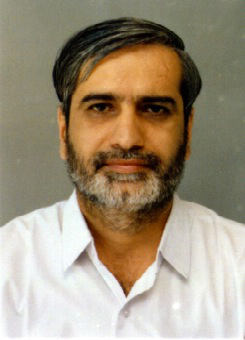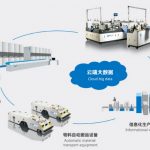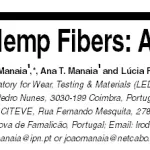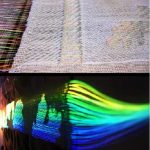 The transformation of algae into fibers is being regarded as one of the top 100 innovations that are expected to play a significant role in shaping the future economy. Natural fibers are popular and their demand is overall on the rise because of their look and feel but the performance of synthetics is forcing producers to emulate the comfort of natural fibers, and also to develop natural fibers with the easy-care properties of synthetics. The demand for synthetic and cellulosic man-made fibers is expected to remain high in the coming years. But the growth potential for cotton will be limited due to an intensifying competition for the farmland availability vis-a-vis the food production. In a comparison of areas needed to produce 1 tonne of fibres, 67 ha are required for wool production against only 0.8 ha for viscose fibres – whilst no agricultural area at all is needed for the production of synthetic fibres. A stronger use of natural fibres also leads to rising global food prices – because agricultural areas are more and more put to different uses in order to produce raw materials for industry. Man-made fibres ease the strain on agricultural areas and thus make contributions to sustainability without aggravating the food situation. It is estimated that only 0.8% of currently produced volumes of petroleum products are needed for the global production of synthetic man-made fibres.The global trend is to substitute cotton with industrial hemp which grows prolific on hilly and less fertile soil without any need for irrigation while stabilizing erosion, a key ecosystem service. The second most important natural fiber is jute which is predominantly used as a substitute for plastic packaging. Cellulosic man-made fibres do not compete with food production, either. Only 0.2 % of amounts of wood felled globally are used for the manufacture of cellulosic man-made fibres. Also, wood used for this purpose comes from sustainably managed plantations or marginal productivity areas that are unsuitable for food crops due to soil conditions. Limited water resources is another factor in favour of man-made fibres It is estimated that in cotton growing some 25000 m3 litres of water are needed to produce 1 tonne of cotton fibres – which is highly objectionable in ecological terms. This is over 70 times the water quantity needed for viscose fibre production and over 6000 times more than what is required in polyester fibre production.
The transformation of algae into fibers is being regarded as one of the top 100 innovations that are expected to play a significant role in shaping the future economy. Natural fibers are popular and their demand is overall on the rise because of their look and feel but the performance of synthetics is forcing producers to emulate the comfort of natural fibers, and also to develop natural fibers with the easy-care properties of synthetics. The demand for synthetic and cellulosic man-made fibers is expected to remain high in the coming years. But the growth potential for cotton will be limited due to an intensifying competition for the farmland availability vis-a-vis the food production. In a comparison of areas needed to produce 1 tonne of fibres, 67 ha are required for wool production against only 0.8 ha for viscose fibres – whilst no agricultural area at all is needed for the production of synthetic fibres. A stronger use of natural fibres also leads to rising global food prices – because agricultural areas are more and more put to different uses in order to produce raw materials for industry. Man-made fibres ease the strain on agricultural areas and thus make contributions to sustainability without aggravating the food situation. It is estimated that only 0.8% of currently produced volumes of petroleum products are needed for the global production of synthetic man-made fibres.The global trend is to substitute cotton with industrial hemp which grows prolific on hilly and less fertile soil without any need for irrigation while stabilizing erosion, a key ecosystem service. The second most important natural fiber is jute which is predominantly used as a substitute for plastic packaging. Cellulosic man-made fibres do not compete with food production, either. Only 0.2 % of amounts of wood felled globally are used for the manufacture of cellulosic man-made fibres. Also, wood used for this purpose comes from sustainably managed plantations or marginal productivity areas that are unsuitable for food crops due to soil conditions. Limited water resources is another factor in favour of man-made fibres It is estimated that in cotton growing some 25000 m3 litres of water are needed to produce 1 tonne of cotton fibres – which is highly objectionable in ecological terms. This is over 70 times the water quantity needed for viscose fibre production and over 6000 times more than what is required in polyester fibre production.
Chinese researchers are exploring the potential of algae as a source for fibers. They are found to be fragile and suitable for medical textiles such as bandages and surgical dressing. The process to extract raw materials for fibers from kelp is already in place. These fibers are stronger and more durable than cotton. The research team at the National Laboratory for New Materials of the University of Qingdao has tested the extraction of high strength alginate fibers from a wide variety of brown, green and red algae. They have found that the new fibers are resistant to fire and electromagnetic waves. Their findings suggest that the algae-based fibers provide a unique raw material to manufacture special clothing, such as fireproof gear, medical uniforms and protective clothing with military applications. A 1,000 tons fiber plant in Qingdao is already operational since last 3 years. The plant is capable of extracting 200 to 250 kilograms of raw material (alginate) for each ton of dry algae. It is reported that the cost of production of alginate fiber varies from $8,000 to 10,000 per ton. China has the required resources to produce 1.9 million tons of renewable alginate fibers annually making algae fibers the third most important natural fiber on the market. Hence, China (and the world) could further reduce its dependency on pesticide dependent and water intensive cotton without the need of land space for farming. More producers are entering the market in China, Taiwan, and Austria.
However, I have yet to come across any research initiatives in India in this area.
G.D. JASUJA
Managing Editor





